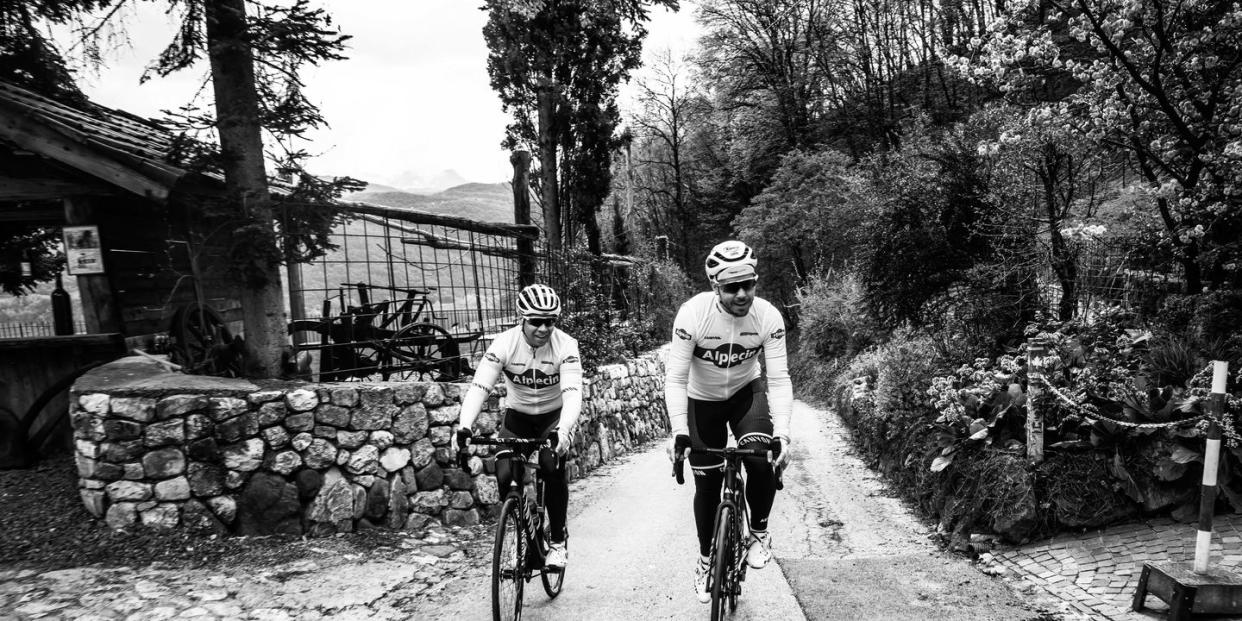This New York City Lawyer Trained Like the Pros for a Week. Here's What He Learned

Every diehard cycling fan, sitting on the sofa’s edge while their Tour de France favorites summit a savagely steep Alpine climb, pictures themselves battling the same serpentine roads.
Thirty-seven-year-old lawyer Jonathan Canfield from New York City sure has. “I can just envision gritting my teeth and having to dig deep to put in an effort that would push me —a cycling mortal—to my absolute limit,” wrote Canfield in his application to Team Alpecin, an amateur branch of Alpecin Cycling.
This summer Canfield will get that chance. He’s the first American selected to join the gran fondo team—which has been supported with elite-level gear, nutrition, and training by the German caffeinated hair product manufacturer for the past 12 years. On July 21st, they will race the 135-kilometers Stage 20 of the Tour de France between Albertville and Val Thorens—a brutal route with 14,500 feet of total climbing—at L’étape du Tour.
In the middle of his first training camp in the small mountain-town of Caldaro, Italy, Canfield offers an inside look at what an amateur learns when he lives his days like a pro.
Form Makes You Fast
The biggest game changer for Canfield so far has been cornering at speed. “I thought I was pretty comfortable on a bike, but I’m still not comfortable with a lot of things we are trying out here,” he says. “I always cornered with my hands on my hoods, but the drops are way better because it puts your body in the proper position and gives you more braking power. Now I’m conscious about downshifting before the turn, entering with speed, extending my knee into the corner, and traveling through the apex of the corner. As we were descending down Col di Lana, I was hitting 52 mph and navigating all these hairpins. I’ve learned that about 75 percent of cornering is just having confidence and understanding what the bike and tires can do.”
Making the Food-Fuel Connection Feels Good
As a New York City lawyer, Canfield’s eating habits include a fair share of restaurants and takeout without a ton of thought. “At camp, the food we eat is designed to fuel our rides. So we’ll have pasta after a five-hour ride to replenish our glycogen stores quickly. And all the food is fresh and natural and nutritious,” he says. Canfield dropped six pounds over the course of camp. The riding is a huge factor, of course, but the properly timed and thought-out nutrition helps a lot, he says. “I’m going to make better decisions about eating out and takeout, and when choosing my meals, be more conscious of what physical activity I have done. If I haven’t ridden that day, I don’t need the big plate.

When It Comes to Gear: Believe the Hype
“I’ll be honest, when Katusha was here telling us that we should wear this particular base layer with this jersey and this jacket, I thought, ‘This sounds like bullshit.’ But when you’re out on the road, it makes a huge difference. Wearing the proper base layer really does pull the sweat away while I’m climbing, so when I’m done with the climb, I’m not freezing on the descent,” Canfield says.
His favorite tip: “Layer like an onion,” he says. “You put all the layers on when you start and peel them off as you need as the day goes on.”
Proper Pacing Gets You to the Finish Line Faster
“I went out the first day as hard as I could and then popped and pedaled squares all the way home,” Canfield says. “I’ve never worn a heart rate monitor or worked with power. Now I’ve learned to pedal to specific heart rate and power zones to make sure I’m not going into the red.”
The result: By learning to ride within his ability, Canfield finishes hard rides that otherwise would have cracked him. “On the second climb of the day, I saw my heart rate getting up to 188, well above where it should have been. So I pulled back. When I got to a big three-mile climb just six miles later, I was able to make it over it. I wouldn’t have if I’d continued in the red earlier on.”
('You Might Also Like',)